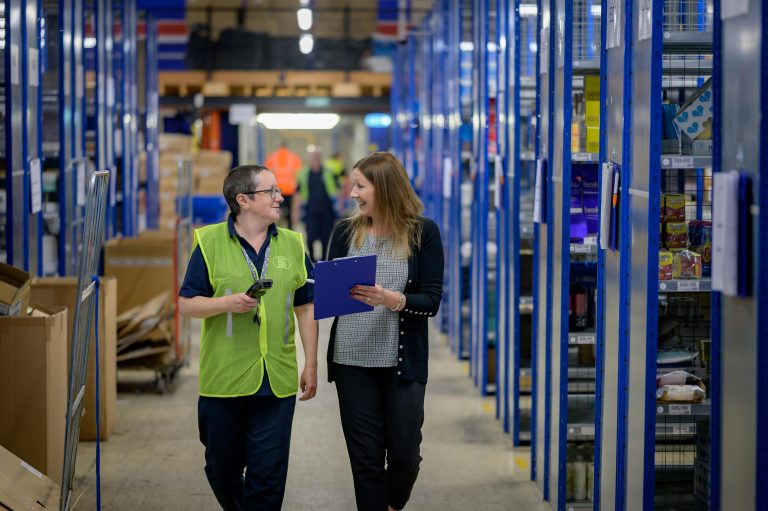Investing in new inventory, warehousing, or manufacturing software is a big step—but getting your team trained on it is where the real change begins. Training can make or break your rollout and sets the tone for how confident your staff feels, how consistently your team uses the tools, and how much value your business ultimately gets from the software.
But one of the first decisions you’ll face is how that training should happen.
Do you bring in a trainer for a few days of onsite support? Or do you opt for remote walkthroughs, documentation, or self-paced videos? Both can work. But they serve very different purposes.
Here’s a breakdown of what onsite and self-guided training each offer, who they’re best for, and how to decide what’s right for your business.
What Is Onsite Training?
Onsite training brings a specialist directly into your space—whether it’s a warehouse, office, production floor, or a bit of all three.
They work with your team in real time, using your actual systems, inventory, and workflows. There’s no generic setup. Everything is done in the context of your day-to-day operation.
Benefits of Onsite Training:
- Hands-on instruction in your environment
Trainers see your actual layout, your labeling system, your staff, and how everything functions in practice—not just in theory. - Customized guidance for your workflows
Onsite trainers can adjust best practices to match how you work, not how a textbook says you should. - Instant feedback and issue resolution
Got a hiccup in your process? Need help with a weird barcode? Onsite support means problems get solved immediately. - Stronger team buy-in
When staff can ask questions in the moment and feel supported, they’re far more likely to adopt the new system confidently. - Live walk-throughs with real data
No mock data or simulations—your team learns with the actual inventory and orders they’ll be handling every day.
Solving Real Problems in Real Time
Let’s say your bins are labeled inconsistently—some handwritten, some printed, and some missing altogether. That’s the kind of issue an onsite trainer spots immediately while walking your floor.
Instead of working around the problem like a remote trainer might, the onsite expert pauses the training, explains why this is creating errors, and works with your team to relabel bins and build a consistent location strategy.
The result? Less confusion, better scans, and faster picks—starting that same day.
What Is Self-Guided or Remote Training?
Self-guided or remote training refers to digital resources like video tutorials, written documentation, online Q&As, and scheduled virtual sessions. This type of training can be flexible and provide a lower cost. It works well for teams that are tech-savvy, structured, or working with a limited budget or timeline.
Benefits of Self-Guided or Remote Training:
- Lower upfront investment
Without travel or onsite scheduling, remote training typically costs less—making it attractive for startups or budget-conscious teams. - Flexible pacing
Team members can learn at their own speed, revisit material, and train around their schedule. - Good for geographically dispersed teams
If your team is spread across locations, remote training ensures everyone gets access to the same materials. - Ideal for reinforcement and follow-up
Even teams that receive onsite training can use self-guided resources later as refresher.
When Onsite Training Makes the Most Sense
Not every team needs someone onsite—but many benefit more than they expect. Here are situations where onsite is almost always the better choice:
1. You’re implementing a warehouse or inventory system for the first time
New workflows mean new habits. A trainer helps walk staff through unfamiliar territory, explains “why” behind the tools, and ensures your setup is right from day one.
2. You have a warehouse, shop floor, or fulfillment team involved
Training warehouse staff with a printed manual? Not ideal. Onsite training allows for real-time demonstration in their actual workspace—where muscle memory matters.
3. You’re rolling out a big change across departments
When inventory systems touch purchasing, sales, operations, and fulfillment, it’s crucial to get everyone on the same page fast. An onsite trainer acts as a guide and translator across roles.
4. You’ve had issues with adoption or accountability in the past
Sometimes teams “say” they understand a new system but continue to revert to old processes. Face-to-face training often creates stronger accountability and clarity.
5. You want to uncover and fix process gaps while you train
A good onsite trainer doesn’t just teach—they observe. They’ll often catch small inefficiencies or setup mistakes that wouldn’t show up in a Zoom session.
A Smart Investment That Pays for Itself
Imagine a small distribution company invests in two days of onsite inventory training. In those sessions, the trainer helps the team fix three major inefficiencies:
- Pickers were walking across the warehouse multiple times per order.
- Inventory was being double-counted in two zones.
- Labels weren’t matching item records, causing scanning errors.
After the adjustments, fulfillment speeds up by 20%, and inventory mistakes drop by 90%. Over the next six months, the company estimates it saved tens of thousands in labor time, order corrections, and lost sales.
All because they invested upfront in training that addressed their real problems—not just the software interface.
When Remote or Self-Guided Training Is a Better Fit
Of course, not every situation calls for onsite support. There are plenty of times when remote options can provide the answers your team needs:
1. Your team is small and tech-savvy
If your users are comfortable exploring new tools, don’t mind reading docs, and already know inventory basics, they can often succeed with self-paced learning.
2. You’re adding new features, not starting from scratch
When the core system is already in place and your team just needs to learn a new module or workflow, video walkthroughs or virtual sessions may be sufficient.
3. You’re refreshing training for existing employees
For refresher courses or new hires joining a trained team, pre-recorded materials can help maintain consistency and reduce trainer time.
4. You have strong internal champions
If you’ve got one or two people in-house who understand the system deeply, they can often lead internal training using provided materials.
Hybrid Training: The Best of Both Worlds
Some of the most effective rollouts combine onsite training upfront with ongoing remote support.
Here’s how that might look:
- A trainer spends 1–2 days onsite for setup, team walk-throughs, and live task training.
- After the initial training, your team gets access to recorded videos, checklists, or Q&A support for continued learning.
- Follow-up calls or virtual sessions reinforce progress and answer new questions as they come up.
This kind of approach blends the real-time, in-person value of onsite support with the cost-efficiency and flexibility of digital learning.
Final Thoughts: Choose the Right Training for Where You’re At
Training isn’t one-size-fits-all. What works for a fast-moving warehouse with a 15-person team might not make sense for a 3-person office reordering parts once a month, but regardless of size, one principle holds true: Your team won’t use what they don’t understand.
The best training option is the one that gets your people confident, competent, and ready to hit the ground running. Whether that’s in-person, on-screen, or a combination of both—make the choice that reflects how your business actually works. Because great software is only as good as the people using it.



